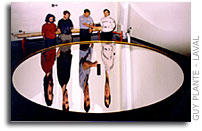NASA Liquid-Mirror Telescope on Moon Might See Deeper Back in Time

Someday, astronauts on the moon may pour liquid onto a disc-shaped mesh to make a huge mirror for a powerful telescope, according to a technical article just made public.
The liquid would include a silver-coated surface, and would be part of an optical-infrared telescope with a 66-foot (20-meter) to 328-foot (100 meter) aperture capable of observing objects 100 to 1,000 times fainter than the James Webb Space Telescope, the authors say. The technical paper will appear in the June 21, 2007, issue of the journal, Nature.
“In this case we have shown how the moon is ideal (for) using liquid mirror technology to build a telescope much larger than we can affordably build in space,” said S. Pete Worden, director of NASA Ames Research Center in California’s Silicon Valley, and a co-author of the technical paper. The lead author is Ermanno Borra, Laval University, Quebec, Canada. “Such telescopes, perhaps 100 meters in diameter can see back to the early phases of the universe after the Big Bang,” Worden added.
The authors envision making lunar, infrared telescopes to study normal and dwarf galaxies.
“The lunar, liquid-mirror project was supported by the NASA Institute for Advanced Concepts. It enabled a team of scientists including myself to show how the moon – our first target in the Vision for Space Exploration (VSE) – might support astronomy,” Worden explained. ” We hope that this or similar possibilities will excite the scientific community about the opportunities contained within the VSE,” Worden observed.
According to the article, an uncoated mirror would be carried to the moon in a drum that astronauts would empty into a rotating mesh, robotically unfolded like an umbrella.
“Surface tension would prevent the liquid from falling through the small holes of the mesh,” the authors said.
The major advantages of liquid telescope mirrors include ease of shipping, assembling and maintenance, “which are far easier than for a solid mirror,” the authors note.
In laboratory experiments, the researchers used a liquid made of ‘ionic salts’ that remains fluid at very low temperatures. The scientists deposited a fine layer of chromium particles on the liquid and then added a layer of silver particles. The researchers say that the reflectiveness of the liquid mirror is not yet adequate, but “it is now only a matter of technological improvement.”
The authors say they will continue to experiment to develop more ways to make liquid mirrors. The researchers predict that the first lunar, liquid-mirror telescope will be built no earlier than 2020.
Borra received a grant from the Canadian Space Agency to conduct his studies. The other authors include: Omar Seddiki of Laval University, Quebec, Canada; Roger Angel and Daniel Eisenstein, both from the University of Arizona, Tucson; Paul Hickson, University of British Columbia, Vancouver, Canada; and Kenneth Seddon, The Queen’s University of Belfast, U.K.
Materials science: Reflections on ionic liquids, Nature pp917 – 918
Ionic liquids are generally regarded as solvents, but these modular, tunable compounds have far greater technological potential. With a coat of silver, they become ideal materials for the liquid mirror of a space telescope.
Letter Nature 447, 979-981 (21 June 2007)
Deposition of metal films on an ionic liquid as a basis for a lunar telescope, Nature









